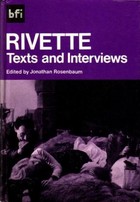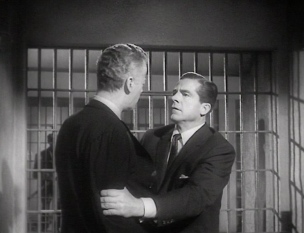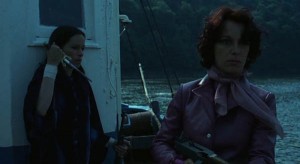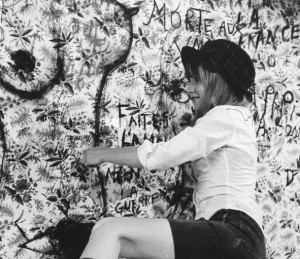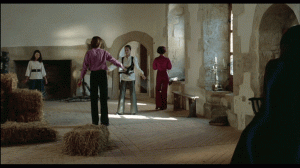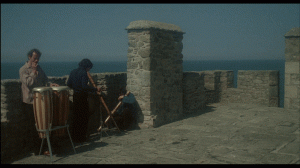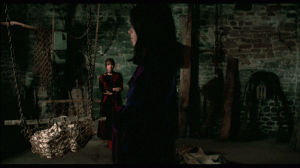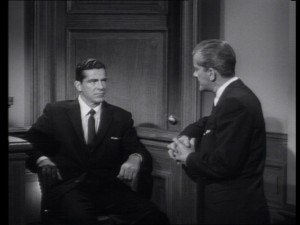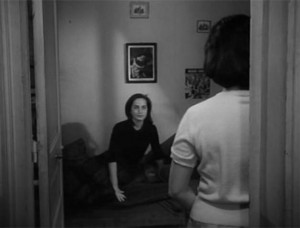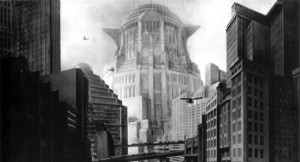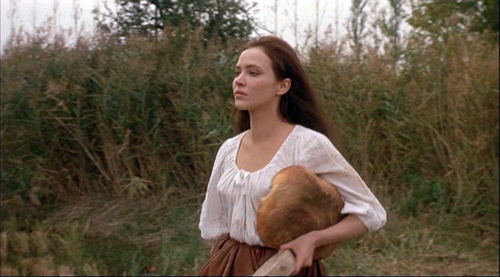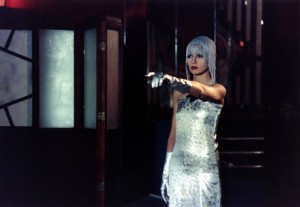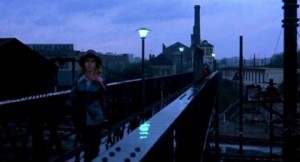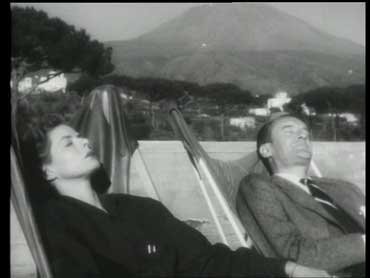This book was published in 1977 by the British Film Institute and has been long out of print, although nearly all its contents has been reprinted on the excellent Jacques Rivette website, “Order of the Exile”. — J.R.
Rather than be considered in isolation, this book should be regarded as part of a general effort to make the work of Jacques Rivette available, in every sense of the term. This is not to imply that the following texts and interviews are being offered as a mere supplement to his films: if the entire body of Rivette’s work can be read as a series of evolving reflections on the cinema, the critical work contained in this volume is indissolubly linked with the critical work represented by his film-making. From this standpoint, it is not enough to say (for instance) that Rivette’s 1957 review of Fritz Lang’s Beyond a Reasonable Doubt helps to ‘explain’ — indeed, provides a veritable blueprint for — many of the preoccupations of his 1976 film Noroit. One of the assumptions of this collection is that it might be equally valuable to view Noroit as a key towards understanding Rivette’s important text on Lang.
More specifically, this book is primarily designed to accompany a season of films at the National Film Theatre which is itself intended to place Rivette’s work within a critical and reflective context. Both book and season come at a time when most of Rivette’s important work remains materially inaccessible in England and America: only Paris Nous Appartient and Céline et Julie vont en bateau are currently in distribution in the UK (both by Contemporary Films), while nothing after L’Amour fou is available in the US; and an examination of the Bibliography at the end of this volume will show that, apart from a few brief and/or incomplete translations, none of Rivette’s writing has previously appeared in English. It should be stressed that many independent factors are responsible for this overall neglect. Quite apart from the unusual lengths of L’Amour fou, both versions of Out 1 and even Céline et Julie, the successful run of the latter in London last autumn only helped to demonstrate (once again) that a large segment of the film-going public continues to be well ahead of many of the regular film reviewers. There is nothing new about this state of affairs, in England or anywhere else, but it seems worth noting that if Rivette’s most immediately legible and ‘commercial’ film went directly over the heads of some of London’s most influential critics, the chances of gaining their support for works as experimental as Out 1: Spectre or Noroit do not seem very substantial. One also has to consider that unlike any of his former ‘New Wave’ colleagues — Godard, Truffaut, Chabrol and even Rohmer — Rivette has never shown much aptitude or extended interest in ‘selling’ his work to a wider public, pursuing any of those elaborate public relations manoeuvres (apart from the occasional interview or festival appearance) that are usually felt to be essential in imposing a director’s name on the public’s consciousness. Rather like Godard but unlike Chabrol, Rohmer and Truffaut, he has regarded all his work since L’Amour fou as exploratory ‘work in progress’, and it is the actual process of this work that interests him more than the ‘product’, marketable or otherwise, that results from it. The art (or craft) of a Chabrol or a Rohmer — or of a Bresson, an Eisenstein, a Tati or a Hitchcock — is to fill in a predestined design, ‘realize’ a prefigured pattern. The interest of Rivette, at least since L’Amour fou, is to combine prefigured elements with relatively unpredictable and uncontrollable ones, and see what occurs. This invariably places the work itself in a state of perpetual suspense (and suspension) where the spectator’s uncertainties are not at all unrelated to the director’s.
There are many interpretations that can be made of the consequences of this approach, and although it is not my ambition here to explore any of these at length — a critical task that certain other texts have assumed in part, some of which are cited as ‘suggested criticism’ in the Biofilmography — a few of the implications of Rivette’s methods might be briefly noted. The profound ‘mysteriousness’ of all his films on one level or another, despite their radically different procedures; the declaration, near the end of the first interview in this collection, that ‘the cinema is necessarily fascination and rape, that is how it acts on people; it is something pretty unclear, something one sees shrouded in darkness, where you project the same things as in dreams’; the increasing rejection of any ‘phenomenological world’, apart from the film-viewing situation itself, in Duelle and Noroit — these and related matters raise serious political and philosophical questions that most writing about Rivette has tended to avoid.
While Rivette’s initial formation must undoubtedly be situated to a certain degree within the existential Catholicism and illusionism that lies at the roots of André Bazin’s critical writing — belying a ‘taste and theory’ which, as Annette Michelson has reminded us, is ‘fundamentally antipoetic, resolutely antimodernist (1) — there is little question that Rivette’s development, like Godard’s, has largely proceeded in opposition to various notions associated with Bazin. This can be seen first of all in many of his earliest critical pieces, where the opposition takes various forms. Rivette’s critical discovery of Howard Hawks in 1953 (preceded only by Manny Farber’s in the pages of The Nation) was couched in terms that elicited Bazin’s sharp disapproval (‘You can see the danger, which is an aesthetic cult of personality’: ‘La Politique des Auteurs’, Cahiers du cinéma, April 1957); if one places Rivette’s ‘Letter on Rossellini’ alongside Bazin’s subsequent ‘Défense de Rossellini’ (translated in What is Cinema?, Vol II, University of California Press, 1971), the differences in critical method and decorum are so striking that one can scarcely take the former to be the labors of a dutiful disciple; and Rivette’s indefatigable, no less polemical celebrations over these same years of Hitchcock, Preminger, Nicholas Ray and Lang’s last American film clearly didn’t coincide with Bazin’s sympathies. (In the same issue of Cahiers containing Rivette’s review of Beyond a Reasonable Doubt, Bazin labeled the film ‘not worth bothering with’ in the Conseil des Dix.)
Examining ‘The Hand’ at closer range, it should become apparent that the thrust of Rivette’s review is a calculated assault on the notion of the ‘vraisemblable’ (2) which is closely allied to Bazin’s defence of realism, If this difficult but rewarding text seems to bear a dialectical relation to Rivette’s earlier essay on Rossellini — implicitly endorsing Lang’s ‘absolute contempt’ for his characters (which is confirmed by Lang’s own testimony about this film in Lotte Eisner’s recent book on the director) after defending the expression of Rossellini’s love for Ingrid Bergman: and propounding, after an application of Bazin’s ‘neo-realist’ television aesthetic (the virtues of ‘direct cinema’ and an open form), an anti-realist aesthetic based on Lang’s ‘indirect” means of expression and his ‘totally closed world’ — the same contradictions are to be found in Rivette’s first feature, where neo-realist (Bazinian) and expressionist (anti-Bazinian) influences run virtually neck and neck.
On the one hand, there is the pronounced phenomenological side of Paris Nous Appartient, frequently remarked upon by contemporary reviewers: the desire to bear witness to the mood and experience of a particular place and time (‘June 1957’ reads the opening title) that continues to give the film, for all its limitations, a rather acute degree of historical pathos. (And despite the post-synchronization, even the soundtrack is eerily prophetic of the urban paranoia of subsequent decades: note the remarks of an American about Nixon, overheard in a cafe towards the end of the film.) The phenomenological aspect is equally present in the film’s respect for durations — not so much a matter of long takes, which the exigencies of the shooting made impractical, as the labyrinthine progress of the heroine in her ‘quest’, up dark stairways and down narrow hallways, and, above all, the extended narrative treatment of the sequence charting her movements throughout a single night and morning, after receiving Gerard’s note threatening suicide. Yet at the same time, the Langian impulse to turn all this experience into a formalist brand of metaphysics — acknowledged in the direct quote of the Tower of Babel sequence from Metropolis — veers the film in quite a different direction which, given all the unforeseen twists, cheated expectations and reversals in the plot, might be construed as being tantamount to a denial of the real. The tension between these antithetical approaches — faith and skepticism, freedom and determinism, paranoia and chaos, “Paris belongs to us’ and ‘Paris belongs to no one’ — is of course the film’s subject, and Rivette’s designation of Paris Nous Appartient as an ‘anti-thesis’ film bears this out.
But if Rivette arrived at this contradiction on a thematic and stylistic level, he was not to realise its formal possibilities and implications until some years later, when he embarked on the adventure of L’Amour fou, an experience that is described in some detail in the first interview of this collection. In between came his protracted struggles with La Religieuse, the most overtly political of all his films, whose experimental aspects (also described in the first interview) are relatively submerged — a film that, for better and for worse, and discounting its musical ambitions, shows the marked influence of some of Otto Preminger’s films in the 50s and early 60s. Certainly the most traditional of Rivette’s films in method and appearance, it remains compelling thanks to its rigorous adherence to Diderot’s protest theme (despite an adaptation which necessarily avoids the question of the novel’s inception — as a practical joke of Diderot’s designed to lure an old friend back to Paris), to Anna Karina’s remarkable performance as Suzanne Simonin, and to Rivette’s resourceful mise en scene — the latter a concern that he was not to take up and explore again, in relative isolation from other formal elements, until ten years later, in Duelle and Noroit.
Turning to the two versions of Out 1 — dealt with in the second interview here, and unquestionably Rivette’s most important accomplishment to date — we arrive at a work whose separate forms (to judge from reports of the longer version) describe yet another formula for the two sides of the Rivettian dialectic. The decision ‘to adopt a perspective that is beyond good or bad’ and film ‘raw’ improvisation by actors who have invented their own characters, in a ‘pseudo-documentary’ manner — reportedly reaching an apogee of sorts in a 45-minute take of a rehearsal by Michel Lonsdale’s theatre group — where fiction gradually proliferates’, presumably leads to a kind of parody-summation of Bazinian notions about realism in the 760-minute version. (‘To my mind, Out 1 [like Céline et Julie] is also a kind of comedy,’ Rivette has noted.)
Contesting and contrasting this, in the subsequent editing of the 255-minute Spectre, is a very anti-Bazinian demonstration of ‘how the very principle of montage risks becoming a principle of rejection and suppression — and not merely of elision, but quite literally of subtraction, erasure, or even impediment and “persecution” [of the spectator-voyeur], whereby ‘montage doesn’t mean adding but withdrawing. . . not doing but un-doing: the negative at work.’ In all fairness, it should be noted that in the preceding quotation Rivette is describing not Out 1: Spectre – which wasn’t shot until a year later — but Vera Chytilova’s About Something Else, in a discussion of montage with Jean Narboni and Sylvie Pierre which comprises the final critical text included here. Yet certain comments on editing in this piece (not merely in relation to Chytilova’s film, but also in reference to Godard’s Made in USA and Straub’s Not Reconciled) anticipate so many of his own procedures, particularly in the first and last hours of Spectre, that it is difficult not to read them (at least in part) as a prospectus.
The final text by Rivette included here is a prospectus, written not for publication but for presentation to the Centre National de la Cinématographie as a request for a government advance on the project Les Filles du Feu (subsequently retitled Scenes de la Vie Parallele). It is included here solely for its intrinsic interest: not as a critical piece or manifesto or even, necessarily, as a ‘preview of coming attractions’, (3) but merely as a token acknowledgment of some of Rivette’s current ambitions and interests. Ideally, a collection of this sort should have been longer. A more comprehensive sampling of Rivette’s criticism might include his texts (or remarks, in roundtable discussions) on film criticism, Sommarlek, Les 400 Coups, Hiroshima, Mon Amour, Le Testament d’Orphée, Splendor in the Grass, Proces de Jeanne d’Arc, Monsieur Verdoux, Muriel, Franju’s Judex, and at least part of his writing on Hawks, Hitchcock, Mizoguchi, Preminger and Renoir — to cite only a few examples. It is also worth remarking that, as the most fanatical cinephile of his generation, Rivette is paradoxically the figure who was most instrumental in inaugurating interviews with figures outside the world of film in Cahiers du cinéma: Roland Barthes (1963), Pierre Boulez and Claude Levi-Strauss (1964).
In the course of editing this book, it was decided at an early stage that precedence would be given to (1) interviews and texts that were unavailable in English and (2) those which came closest to defining in some depth the continuity of Rivette’s concerns. For this reason, short shrift has been paid to all three of Rivette’s last features, apart from their inclusion in the Biofilmography and passing references to them here. As a film that has already attracted a relatively wide audience and has been discussed in some detail by Rivette in interviews published in Sight and Sound and Film Comment, Céline et Julie vont en bateau did not seem to warrant the kind of extended treatment accorded here to L’Amour fou and the two versions of Out 1; even if it had, there are no detailed interviews about the film available in French. The same is true, alas, for Duelle and Noroit, at least at the moment — an absence which seems more unfortunate, because both films have already been subject to a great deal of misunderstanding. (4)
Considering the fact that these films represent only the second and third parts of a tetralogy whose eventual completion is still in question — after the disastrous commercial and critical reception of Duelle in France, and prior to the release of Noroit — it would be premature to attempt an extended response to these works in the present collection; the prospectus included here is scarcely more than an acknowledgment of this gap. I can only hazard the personal conviction that, with the passage of time, both films will be recognized as significant extensions of (and advances in) Rivette’s explorations — even if, from the present standpoint, the former seems to hark back to some of the illusionist premises of Rivette’s earliest work, while the latter abandons them with such virulence that it also rejects most of the forms of narrative suspense that Rivette’s cinema has formerly depended upon. Both works, one might add, represent audacious rejections of ‘contemporary relevance’ in terms of their subject matter — refusals which have already provoked certain political questions, alluded to earlier in this introduction, regarding the implication of Rivette’s formalism and the progressive abandonment of interest in ‘lived experience’. Rather than attempt to answer these questions here, I will merely assert that, as a serious, critical investigation into the diverse partis pris of illusionistic narrative, there is a great deal more political import to be found in these films — directly addressing the manner in which spectacle and spectator conspire to produce or deny meanings — than in the collected works of such purely unreflexive illusionist directors as Fassbinder, Herzog, Pakula or Rosi. And a response of Rivette’s in one of his earliest interviews (Télérama, 1 April 1962) may not be entirely irrelevant here: asked whether he believed ‘in a spiritual domain’, he replied, ‘Perhaps, but only through the concrete. If that means being materialist, I think that’s what I am more and more.’
In closing, a few final specifications about the pages that follow. With the exception of the first interview, where a brief and inconsequential preface has been omitted, all the pieces presented here are virtually complete. The interviews precede the texts because it was felt that the former provide a more readily accessible introduction to Rivette’s ideas than the latter (which require much more careful attention), although each section is ordered chronologically. ‘Of all of us at Cahiers, he was the one who was most fiercely determined to become a director.’ ‘Someone like Rivette, who knows the cinema much better than I, shoots little; people don’t speak of him, or hardly ever. . . If he had made ten films, he would have gone a lot further than I.’ These two statements, by Truffaut and Godard respectively, may help explain why Rivette was the first of the Cahiers critics to embark on film-making. They may also serve as a sort of background to the somewhat exacerbated tone of ‘Letter on Rossellini’, which all but concludes with an impatient clarion call announcing Rivette’s imminent debut as a director (which was to come the following year, with Le Coup du Berger). In his Rossellini monograph (Movie Paperbacks, 1970), Jose Luis Guarner states that this piece ‘is still the finest article written on Rossellini’; as an indication of the particular appeal and influence exerted by Voyage to Italy on Godard and Truffaut as well as Rivette, it is certainly the most revealing. But to see this essay in a proper historical perspective, it should be noted that it was written at a time when the readership and reputation of Cahiers du cinéma were extremely marginal; the proliferation of ‘insider’ references clearly indicates that it was essentially addressed to a small group of friends.
This is also partially true of ‘The Hand’, written over two years later — roughly when Le Coup du Berger was released and Rivette was writing the script for Paris Nous Appartient with Jean Gruault. In this case, Rivette was counting on recent memories of Lang’s film in the minds of his readers; and because few contemporary readers are likely to have this reference point, a great deal of the review might appear to be more abstract than it actually is. For the record, then, one does ‘become aware of a brand of make-up’ — the body make-up of the murdered woman — ‘for purposes of plot’. And the plot in question involves the faking of evidence pointing to the guilt of the Dana Andrews character, who is engaged to Joan Fontaine — a stunt contrived by Andrews himself and Fontaine’s father, a newspaper editor, supposedly in order to demonstrate how easily an innocent man might be condemned to death. After Andrews is brought to trial for murder, Fontaine’s father perishes in a car accident which also destroys the photographs proving Andrews’ innocence — a twist of fate eventually circumvented by the discovery of another document exposing the stunt. On the brink of being pardoned, however, Andrews admits to Fontaine that he actually did commit the murder. This ultimately provokes her to permit an investigator who is much enamored of her to phone the governor at the last minute and have him cancel the pardon. The ‘scarcely wrinkled hand in the penultimate shot’ referred to by Rivette is the governor’s hand in close-up, resting beside the pardon on his desk which he has just refused to sign. (In fact, one sees both hands, on either side of the pardon — one of them clenched, the other at rest.) And the final shot is a fixed set-up of the impassive Andrews being led away from the camera by guards.
In its original appearance in Cahiers (after the magazine had switched to its larger format), ‘Montage’ is laid out in adjacent vertical columns, with two columns per page; on any two facing pages, the main body of the text occupies the two central columns, while footnotes and/or stills are placed in the outside ones. Unfortunately, it hasn’t been possible to reproduce or approximate this jazzy sort of mise en page here — an effect closer to collage than to montage proper — but an attempt has been made, at least, to keep main text and footnotes within hailing distance of one another, to suggest the original intention. Readers should not be surprised if occasionally they find the footnotes more interesting than the texts they are appended to: as with some of the Sterne-like dashes in ‘Letter on Rossellini’, the gargantuan footnote in ‘The Hand’ and the cabaret performances in Céline et Julie, some of the finer moments in Rivette’s work tend to take the form of spontaneous digressions.
Considering the fact that over eleven years have passed since ‘The Hand’, one can discern several signs of development and refinement in his thinking. If his earlier pieces, in contrast to Godard’s, suggest not so much a passion for paradox as a tolerance for it, his remarks on ‘Montage’ suggest something closer to an absorption and assimilation of contradictions — what Hegel might call a synthesis. Much the same could be said of L’Amour fou, which opened in Paris shortly before Narboni, Pierre and Rivette attended the montage conference in Aix-en-Provence
The basic intention behind the Biofilmography and Bibliography is to offer as much information about Rivette’s career as possible; so an attempt has been made to be inclusive rather than selective. The only exception to this is the ‘suggested criticism’ listed after the credits of each film — a very selective choice which is also to some extent arbitrary, because I haven’t read all the possible candidates. A few further references can be found in the Rivette bibliography of James Monaco’s The New Wave, I omitted most reviews that I read of Céline et Julie and Duelle, my own included, because they finally seemed to be beside the point. Some of the others provide a few helpful starts, but it is my general conviction that the best Rivette criticism remains to be written — much as the best of Rivette’s cinema remains to be seen.
The idea and many of the selections of this book were largely inspired by a somewhat similar collection edited and translated by Adriano April — II cinema di Jacques Rivette, prepared for the 10th ‘Festival of New Cinema’ at Pesaro, 12-19 September 1974 – the first book in any language devoted to Rivette. This is the second, and I am deeply indebted to April’s pioneering and judicious work. For other diverse kinds of assistance, advice and encouragement in relation to this project, I owe particular thanks to Charles Cameron Ball, Ian Christie, Richard Combs, Jan Dawson, Amy Gateff, Jenny Gibson, Connie Greenbaum, Eduardo de Gregorio, John Hughes (for quotes from his Rivette interview), Lorenzo Mans, Tom Milne (especially), Jacques Rivette, James Stoller, Stephane Tchalgadjieff, Paul Willemen and David Wilson. J.R. February 1977 NOTES
- See her Introduction to Noel Burch’s Theory of Film Practice (Seeker & Warburg, 1973, pp. v-xii) and her review of What is Cinema? in Artforum VI. No. 10 (1968). pp. 66-71 — probably the two most valuable expositions of Bazin in English.
- As is explained in an editorial footnote, Rivette’s use of this term was in part suggested by the French title of Lang’s film, Invraisemblable Vérité – permitting a form of word play that cannot be adequately conveyed in English translation. To understand the drift of Rivette’s argument and its implications, it would be helpful to read ‘reasonable’ (and its variants) as ‘plausible’, ‘probable’ or even ‘believable’ throughout the review; all four meanings are implied in the French.
- There has already been a shift, for instance, in the order of the films as it is prefigured here: “The Revenger” has become Part III (Noroit), while the ‘musical comedy’ featuring Carolyn Carlsons, dance company is currently planned as the fourth film
- While Duelle might be described, from a strictly commercial standpoint, as a film ‘aimed’ at a particular kind of audience which no longer exists, the more ambitious and radical procedures of Noroit suggest both an acceptance of the fact of this ‘lost audience’ and a subsequent liberation from this frame of reference – thereby marking a return to the sort of experimentation and ‘pure research’ largely abandoned by Rivette after Spectre.
Originally appeared in Rivette: Texts & Interviews (British Film Institute, 1977), p. 1-8.

